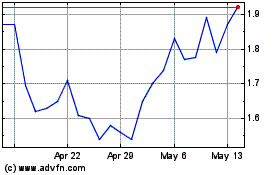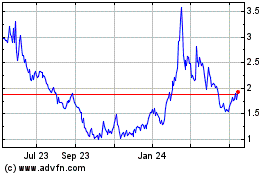Lexicon Pharmaceuticals, Inc. (Nasdaq: LXRX) today announced the
peer-reviewed Journal of American Society of Nephrology (JASN) has
published a research paper analyzing the efficacy and safety of
sotagliflozin, a dual SGLT1 and SGLT2 inhibitor, when added to
insulin in patients with type 1 diabetes (T1D) and chronic kidney
disease (CKD).
The findings from the study, “Efficacy and Safety of
Sotagliflozin in Patients with Type 1 Diabetes and CKD,” concluded
that people with T1D and CKD treated with sotagliflozin and insulin
had similar lowering effects on glycated hemoglobin (HbA1c), the
primary endpoint of the underlying clinical trials, as T1D patients
who do not have CKD. Further, the findings show that sotagliflozin
was associated with a lower to neutral risk of severe hypoglycemia
and did not significantly increase the risk of diabetic
ketoacidosis (DKA) among a small number of DKA events.
Researchers used data from the 52-week pooled inTandem1 and 2
trials and the 24-week inTandem3 trial to assess the effects of
sotagliflozin (200mg [inTandem 1&2 only] or 400mg daily) versus
placebo on HbA1c (primary endpoint), body weight, systolic blood
pressure (BP), insulin dose, and safety endpoints including
adjudicated severe hypoglycemia and DKA, in each case stratified by
CKD.
Of the 1,575 patients in the inTandem1 and 2 trials, 237
patients were identified who had CKD. Of the 1,402 patients in the
inTandem3 trial, 228 patients were identified who had CKD.
At week 24, significant, placebo-adjusted reductions in HbA1c
were observed in inTandem1 and 2: Non-CKD subgroup (sotagliflozin
200mg: -0.4%, 95% CI -0.4 to -0.3; 400mg: -0.4%, 95% CI -0.5 to
-0.3) and CKD subgroup (sotagliflozin 200mg: -0.4%, 95% CI -0.6 to
-0.1; 400mg: -0.3%, 95% CI -0.5 to -0.1). For systolic BP, there
was a significant placebo-adjusted reduction at week 24 with
sotagliflozin in the non-CKD subgroup but no effect in the CKD
subgroup in inTandem1 and 2. At week 52, the incidence of severe
hypoglycemia was lower with sotagliflozin (7% on 200 mg and 4% on
400 mg) compared to placebo (17%) in the CKD subgroup of inTandem1
and 2, whereas the incidence of severe hypoglycemia was 5-6% across
both sotagliflozin and placebo non-CKD subgroups. The incidence of
adjudicated DKA at week 52 in inTandem 1 and 2 was 1%, 5%, and 3%,
respectively, for the placebo, 200 mg, and 400 mg doses in the CKD
subgroup, compared to 0%, 3%, and 4% in the non-CKD subgroup.
Results were generally similar in inTandem3 except systolic BP
was significantly reduced with sotagliflozin versus placebo in CKD
and non-CKD subgroups.
“There hasn’t been a new drug approved for patients living with
type 1 diabetes and chronic kidney disease in decades,” said study
co-author and kidney specialist David Cherney, MD, PhD, University
Health Network, University of Toronto. “Previous studies have shown
the SGLT inhibitors – including sotagliflozin – lower blood
pressure and harmful urinary protein levels to a similar degree in
people with type 1 diabetes compared to people with type 2
diabetes. Our current analysis adds important evidence showing that
sotagliflozin has the potential to provide benefits for patients
with type 1 diabetes and chronic kidney disease, particularly when
appropriate steps are taken to reduce the risk of diabetic
ketoacidosis.”
“People with T1D and CKD urgently need new treatment options. We
believe the findings of this analysis support our position that, if
approved by the FDA, sotagliflozin should be included in
discussions between clinicians and their patients with T1D and CKD
about how to best achieve glycemic control,” said Craig Granowitz,
M.D., Ph.D., Lexicon’s senior vice president and chief medical
officer.
As previously reported, the U.S. Food and Drug Administration
(FDA) has assigned a Prescription Drug User Fee Act (PDUFA) target
action date for ZynquistaTM (sotagliflozin) of December 20,
2024.
Click here to read the abstract of the JASN manuscript.
About SotagliflozinDiscovered using Lexicon’s
unique approach to gene science, sotagliflozin is an oral inhibitor
of two proteins responsible for glucose regulation known as
sodium-glucose cotransporter types 2 and 1 (SGLT2 and SGLT1). SGLT2
is responsible for glucose and sodium reabsorption by the kidney
and SGLT1 is responsible for glucose and sodium absorption in the
gastrointestinal tract. Sotagliflozin has been studied in multiple
patient populations encompassing heart failure, diabetes, and
chronic kidney disease in clinical studies involving approximately
20,000 patients.
About Lexicon Pharmaceuticals Lexicon is a
biopharmaceutical company with a mission of pioneering medicines
that transform patients’ lives. Through the Genome5000™ program,
Lexicon’s unique genomics target discovery platform, Lexicon
scientists studied the role and function of nearly 5,000 genes and
identified more than 100 protein targets with significant
therapeutic potential in a range of diseases. Through the precise
targeting of these proteins, Lexicon is pioneering the discovery
and development of innovative medicines to treat disease safely and
effectively. Lexicon has commercially launched one of these
medicines, INPEFA® (sotagliflozin) in the United States, and has a
pipeline of other promising drug candidates in discovery and
clinical and preclinical development in neuropathic pain, diabetes
and metabolism and other indications. For additional information,
please visit www.lexpharma.com.
Safe Harbor Statement
This press release contains “forward-looking statements,”
including statements relating to sotagliflozin and Lexicon’s
financial position and long-term outlook on its business, growth
and future operating results, discovery, development and
commercialization of products, strategic alliances and intellectual
property, as well as other matters that are not historical facts or
information. All forward-looking statements are based on
management’s current assumptions and expectations and involve
risks, uncertainties and other important factors, specifically
including Lexicon’s ability to meet its capital requirements,
successfully commercialize its approved products, successfully
conduct preclinical and clinical development and obtain necessary
regulatory approvals of its other drug candidates on its
anticipated timelines, achieve its operational objectives, obtain
patent protection for its discoveries and establish strategic
alliances, as well as additional factors relating to manufacturing,
intellectual property rights, and the therapeutic or commercial
value of its approved products and other drug candidates. Any of
these risks, uncertainties and other factors may cause Lexicon’s
actual results to be materially different from any future results
expressed or implied by such forward-looking statements.
Information identifying such important factors is contained under
“Risk Factors” in Lexicon’s annual report on Form 10-K for the year
ended December 31, 2023, as filed with the Securities and Exchange
Commission. Lexicon undertakes no obligation to update or revise
any such forward-looking statements, whether as a result of new
information, future events or otherwise.
For Investor and Media
Inquiries:Lisa DeFrancesco Lexicon Pharmaceuticals,
Inc.lexinvest@lexpharma.com
Lexicon Pharmaceuticals (NASDAQ:LXRX)
Historical Stock Chart
From Dec 2024 to Jan 2025

Lexicon Pharmaceuticals (NASDAQ:LXRX)
Historical Stock Chart
From Jan 2024 to Jan 2025
